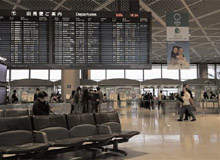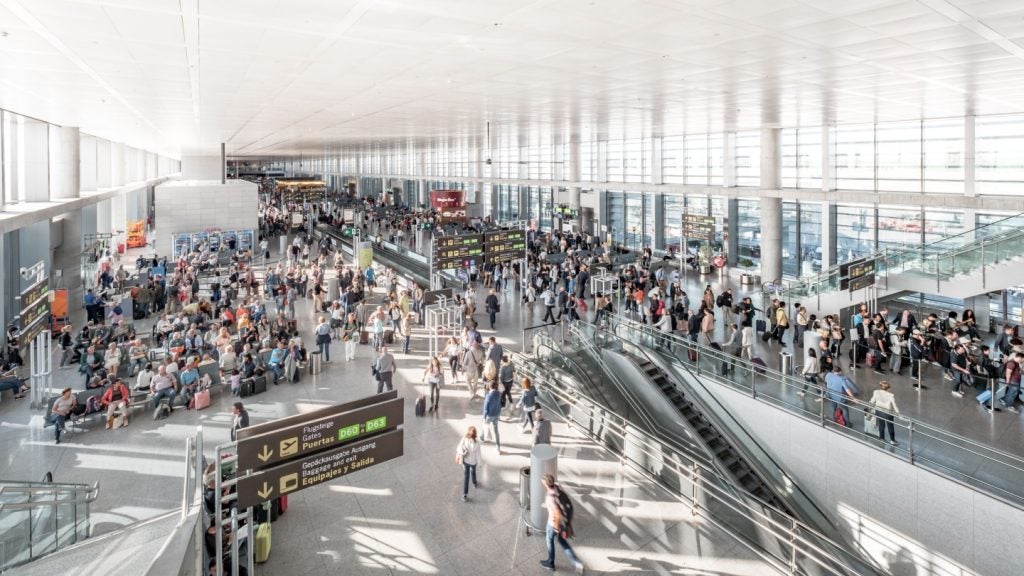
Construction of Terminal 1 at Narita International Airport (NAA) in Tokyo began in 1971 and the terminal was opened in conjunction with the commissioning of the airport in 1978. Reconstruction and extension works are currently under way in the terminal to provide passengers with a setting that offers greater convenience and comfort and to meet future increases in demand.
The reconstruction works are aimed at modifying and improving facility functions by installing additional check-in counters and airline lounges; extending the various areas (departures and arrivals lobbies, passport control area, gate waiting lounge, baggage reclaim area, airline lounges, and the like); improving quake resistance and other disaster prevention systems; and introducing universal signage.
Extension works have been completed in the North Wing, the Central Building and Satellites 1 to 4, and these facilities are now in operation. Reconstruction works are continuing in the South Wing and Satellite 5, and these are due to be completed by the summer of 2006. NAA is also planning the relocation of airlines in its two terminals in conjunction with the completion of the Terminal 1 reconstruction, in response to the increase in code-shared services and the growth in passenger traffic.
RE-USING CONSTRUCTION MATERIALS
The reconstruction of Terminal 1 is striking for its environmental friendliness. Old construction materials such as ceiling louvers and large sashes are being refurbished and re-used instead of being disposed of. Such re-use of materials lowers both construction costs and the amount of time taken to complete the project. Furthermore, by re-using the structural frame intact, it is possible to reduce the amount of waste concrete, reinforcing steel and soil.
The North Wing at Terminal 1 was built in 1971, but the existing building still meets current Japanese requirements for quake-resistance. NAA decided to re-use the structural frame of the building and reinforce the columns with concrete to give them extra strength.
How well do you really know your competitors?
Access the most comprehensive Company Profiles on the market, powered by GlobalData. Save hours of research. Gain competitive edge.

Thank you!
Your download email will arrive shortly
Not ready to buy yet? Download a free sample
We are confident about the unique quality of our Company Profiles. However, we want you to make the most beneficial decision for your business, so we offer a free sample that you can download by submitting the below form
By GlobalDataThe ceiling louvers in the departure lobby showed no sign of degradation and could be used without any problem by simply removing the dust. They were repainted white-grey to give them a brighter impression. The supports for the sashes were checked for deformation, strength and safety. Those that could be re-used were cleaned, polished and painted with fluorocarbon resin, and the bolts in the joints were also retightened.
AIR CONDITIONING, WATER AND LIGHT
Air conditioning in Terminal 1 is zoned to meet the varying needs of different passenger areas, office areas and the concession areas so as to save energy. Large open areas such as the departures lobby have high ceilings and instead of air conditioning the entire area, it is supplied in the lower sections actually used by passengers. The departure lounge, the arrival concourse and other areas are used at different times, so air conditioning is coordinated with flight schedules.
Kitchen wastewater from the terminal restaurants is treated and re-used as flushing water in the toilets. In addition, automatic taps and water-conserving washbasins have been installed to reduce water consumption.
Different sections of the passenger terminal are used at different times. Therefore, the lights are coordinated with flight schedules to switch on and off automatically in each area as required. If there are delays in flight departure or arrival and the lights need to be kept on beyond normal hours, NAA is able to turn on the lights along the relevant passenger flow lines.
Areas with access to sunlight, such as the departures lounge and the arrivals concourse, have been fitted with daylight sensors to coordinate electrical lighting with natural lighting. These controls enable the correct amount of lighting to be provided for each area and help to conserve energy by ensuring that electricity consumption is kept to a minimum.
COMMUNICATIONS FACILITIES
The airport signage system (with lighting) in the passenger terminals makes use of a switch control system so that signs can be switched off after operating hours. Based on the calculation that 900 displays are switched off for six hours a day, this system saves approximately 800kWh per day in Terminal 1 alone.
The flight information systems use plasma displays and LCD monitors in the lobbies. This saves energy and increases the life span of the flight information displays. The four-sided PR terminals that used cathode-ray tubes consume around 600W per display, whereas the new LCD type only consumes about half as much. In addition, the LCD monitors have a longer service-span than the cathode ray tube and plasma display monitors and last around 10 years. This leads to a reduction in industrial waste, as they need to be replaced less frequently.
MINIMISING CONSTRUCTION WASTE
The apron area is paved with highly durable concrete pavement (Continuously Reinforced Concrete Pavement) and remained in since the opening of the airport in 1978. About 15 years into operation, however, cracks began to appear in the pavement and repairs had to be made. Therefore, NAA has been repairing the apron and upgrading it in preparation for the larger aircraft that are expected in the future.
Paving improvements and repairs are usually done by removing and replacing the old paving. However, this type of work in an area as large as the aprons at Narita Airport generates enormous amounts of waste, and is time consuming and expensive. To overcome these problems, NAA undertook numerous studies and developed its own complete bonded concrete overlay method.
The method is to shave a fine surface in existing concrete and lay a thin layer of new concrete pavement to make it bond completely. Its positive environmental implications are that it significantly reduces the volume of waste generated (about 97%) in comparison with the old remove and replace method, makes effective use of the existing paving, and cuts down on the volume of new concrete required.
ADOPTING CRUSHED GRANULAR CONCRETE MATERIAL
The airport has two types of paving – asphalt and concrete. Most roads are paved with asphalt paving composed of some layers of asphalt concrete, sub-base course and sub-grade. New crusher-run is generally used as the sub-base course. However, NAA realised that construction waste such as concrete and asphalt from the repair works in the airport aprons and taxiways could be used as a substitute by converting it into crusher-run, and has continued to use this idea in paving airport roads.
Asphalt and concrete are converted into crusher-run at the construction waste recycling plant and are reused in airport road paving. 120,000t of construction waste was re-used in fiscal 2003. A recycling system is being established within the airport and is playing its part in minimising industrial waste and in making effective use of limited resources.
With these strategies, Narita is leading the way for airports seeking to function along more environmentally friendly lines. At the same time it is not sacrificing the effectiveness of its airport systems.





